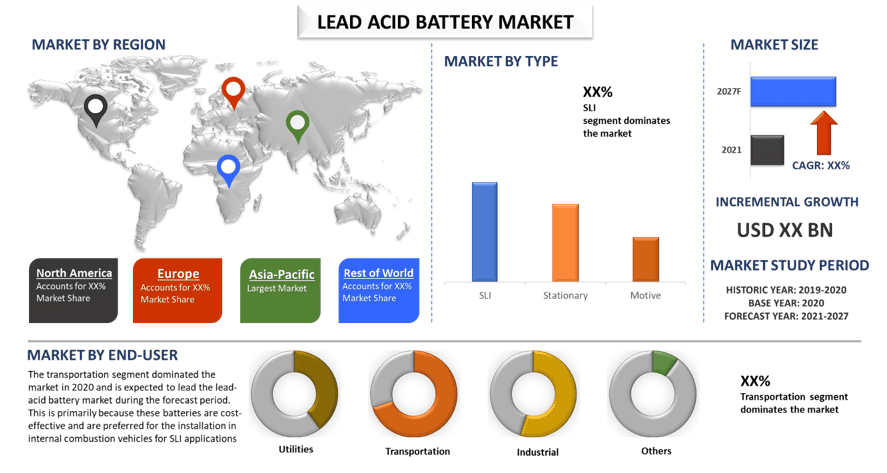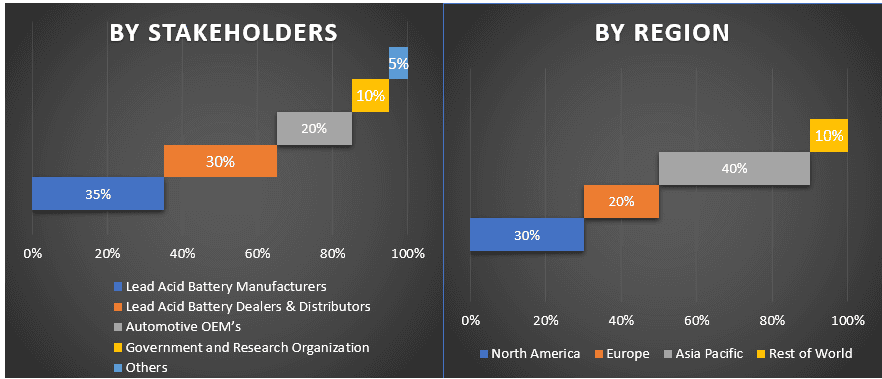- Home
- About Us
- Industry
- Services
- Reading
- Contact Us
Lead Acid Battery Market: Current Analysis and Forecast (2021-2027)
Emphasis on Construction Method (Flooded and VRLA); Type (SLI, Stationary and Motive); Technology (Basic and Advanced); End User (Utilities, Transportation, Industrial and Others); Region and Country

Global Lead Acid Battery Market is anticipated display a CAGR of around ~5% over the forecast period (2021-2027). A lead acid battery is used as an energy storage system and as a power source in a variety of applications. This, in turn, has a positive impact on the global market share of lead acid batteries. These rechargeable batteries have a sulfuric acid solution electrolyte with a lead dioxide cathode and a sponge metallic lead anode. One of largest in the lead-user category is industrial batteries – such as those used for standby power supply system, electrical energy supplies for telephone exchanges, public buildings, hospitals and various industries. Various information centers report a high need for battery storage. Any inconsistencies or power outages in different data centers might be critical for them. As a result, the growing Lead Acid Battery Market Share mostly supports this industry’s back power needs. Furthermore, the UPS systems and Lead Acid Battery Facts used in all of these businesses are mostly Lead Acid Battery systems. As a result, these sectors use a significant volume of this type of battery, resulting in significant Lead Acid Battery Market growth.
Insights Presented in the Report
“Amongst Construction Method, Flooded segment dominated the market in 2020”
Based on construction method, the market is segmented into Flooded and VRLA. The Flooded segment is expected to grow at a higher CAGR during the forecasted period. In diesel-electric submarines, flooded lead–acid batteries are used to power electric motors, while nuclear submarines use them as a backup power source. As a result, increased maritime commerce operations are expected to provide flooded lead–acid batteries with good growth potential during the projection period. Because of their cost-effectiveness, the usage of these batteries in forklift trucks is increasing substantially, as forklift trucks are primarily utilized in the material handling business, where productivity and cheap cost are extremely important
“Amongst Type, SLI segment dominated the market in 2020.”
Based on type, the market is segmented into SLI, Stationary and Motive. The SLI segment is expected to grow at a higher CAGR during the forecasted period. The key benefit of SLI batteries is their high cycle life and reduced vehicle weight. As a result, the emergence of SLI batteries as a cost-effective energy source is fueled by an increase in car sales. Furthermore, these batteries are considered as a cost-effective source of energy by vehicle owners, who replace batteries after a specific time instead of buying expensive alternatives, such as lithium-ion battery, available in the market
“Amongst Technology, Advanced segment dominated the market in 2020.”
Based on technology, the market is segmented into Basic and Advanced. The Advanced segment is expected to grow at a higher CAGR during the forecasted period. The features such as improved battery life along with reduced weight the advanced lead acid batteries are gaining demand in the industry and is expected to grow at a higher CAGR during the forecasted period.
“Amongst End User, Transportation segment dominated the market in 2020.”
Based on end-user, the market is segmented into Utilities, Transportation, Industrial and Others. The Transportation segment is expected to grow at a higher CAGR during the forecasted period. The transportation segment dominated the market in 2020 and is expected to lead the lead-acid battery market during the forecast period. This is primarily because these batteries are cost-effective and are preferred for the installation in internal combustion vehicles for SLI applications.
“Asia Pacific represents as the largest market.”
Based on the estimation, during the projection period of 2021-2027, Asia Pacific is expected to grow at a higher CAGR. China, India, Japan, and South Korea are all major contributors to the Asia-Pacific region. High automobile production and sales, fast industrialization, population increase, and a spike in demand for UPS systems are just a few of the elements driving this region’s growth. The automotive industry generates the majority of revenue for lead–acid batteries in Asia–Pacific, owing to robust demand for passenger automobiles and increased awareness and acceptance of electric vehicles. The electric vehicle section of the automobile industry is rapidly growing in order to minimize carbon emissions. The lead–acid battery is widely employed in electric cars, and its use is steadily increasing. Some of the major players operating in the market includes EnerSys, Exide Industries, Amara Raja Batteries Ltd, C&D Technologies Inc., GS Yuasa Corporation, HBL Power Systems Ltd., Panasonic Corporation, Teledyne Technologies Inc., Clarios, Narada Power etc.
Reasons to buy this report:
- The study includes market sizing and forecasting analysis validated by authenticated key industry experts
- The report presents a quick review of overall industry performance at one glance
- The report covers an in-depth analysis of prominent industry peers with a primary focus on key business financials, product portfolio, expansion strategies, and recent developments
- Detailed examination of drivers, restraints, key trends, and opportunities prevailing in the industry
- The study comprehensively covers the market across different segments
- Deep dive regional & country-level analysis of the industry
Customization Options:
The Global Lead Acid Battery Market can further be customized as per the requirement or any other market segment. Besides this, UMI understands that you may have your own business needs, hence feel free to connect with us to get a report that completely suits your requirements.
Table of Content
A lead acid battery is used as an energy storage system and as a power source in a variety of applications. This, in turn, has a positive impact on the global market share of lead acid batteries. These rechargeable batteries have a sulfuric acid solution electrolyte with a lead dioxide cathode and a sponge metallic lead anode. One of largest in the lead-user category is industrial batteries – such as those used for standby power supply system, electrical energy supplies for telephone exchanges, public buildings, hospitals and various industries. Various information centers report a high need for battery storage. Any inconsistencies or power outages in different data centers might be critical for them. As a result, the growing Lead Acid Battery Market Share mostly supports this industry’s back power needs. Furthermore, the UPS systems and Lead Acid Battery Facts used in all of these businesses are mostly Lead Acid Battery systems. As a result, these sectors use a significant volume of this type of battery, resulting in significant Lead Acid Battery Market growth.
Anode, cathode, and electrolyte are the three main components of a lead cell; the anode is the negative terminal, the cathode is the positive terminal, and the electrolyte joins both of these terminals to drive an electrochemical reaction that produces electricity. A lead–acid battery is made up of a sponge metallic lead anode, a lead-dioxide cathode, and a sulfuric acid solution electrolyte. It is the first battery to be used in a commercial setting. It has dangerous lead in it, but it can be recycled. The electric vehicle section of the automobile industry is rapidly growing in order to minimize carbon emissions. The lead–acid battery is widely employed in electric cars, and its use is steadily increasing. The continuous rising demand for electric vehicles globally is going to add fuel to the growth of lead acid battery as transportation industry plays a very vital role in governments target for zero emission, and electric vehicles is the very first step to reach the set targets.
Analysis of Historical Market Size
Step 1: In-Depth Study of Secondary Sources:
Detailed secondary study was conducted to obtain the historical market size of the Lead Acid Battery Market through company internal sources such as annual report & financial statements, performance presentations, press releases, etc., and external sources including journals, news & articles, government publications, competitor publications, sector reports, third-party database, and other credible publications.
Step 2: Market Segmentation:
After obtaining the historical market size of the Lead Acid Battery, we conducted a detailed secondary analysis to gather historical market insights and share for different segments & sub-segments for major regions. Major segments included in the report are by construction method, type, technology, end-user. Further regional & country-level analyses were conducted to evaluate the overall adoption of the Lead Acid Battery Market in the global context.
Step 3: Factor Analysis:
After acquiring the historical market size of different segments and sub-segments, we conducted a detailed factor analysis to estimate the current market size. Further, we conducted factor analysis using dependent and independent variables such as growing government incentives and demand for eco-friendly transportations etc. Historical trends and their year-on-year impact on the market size and share was analyzed. Demand and supply side scenario was also thoroughly studied.
Current Market Size Estimate & Forecast
Current Market Sizing: Based on actionable insights from the above 3 steps, we arrived at the current market size, key players in the Market, and market shares of the segments and company. All the required percentage split, and market breakdowns were determined using the above-mentioned secondary approach and were verified through primary interviews.
Estimation & Forecasting: For market estimation and forecast, weights were assigned to different factors including drivers & trends, restraints, and opportunities available for the stakeholders. After analyzing these factors, relevant forecasting techniques i.e., bottom-up approach was applied to arrive at the market forecast to 2027 for different segments and subsegments across the major regions globally. The research methodology adopted to estimate the market size encompasses:
- The industry’s market size, in terms of value (US$) and the adoption rate of Lead Acid Battery across the major markets
- All percentage shares, splits, and breakdowns of market segments and sub-segments
- Key players in the Lead Acid Battery Market in terms of products offered. Also, the growth strategies adopted by these players to compete in the fast-growing market.
Market Size and Share Validation
Primary Research: In-depth interviews were conducted with the Key Opinion Leaders (KOLs) including Top Level Executives (CXO/VPs, Sales Head, Marketing Head, Operational Head, and Regional Head, Country Head, etc.) across major countries. Primary research findings were then summarized, and statistical analysis was performed to prove the stated hypothesis. Inputs from primary research were consolidated with secondary findings, hence turning information into actionable insights.
Split of Primary Participants in Different Regions

Market Engineering
Data triangulation technique was employed to complete the overall market estimation and to arrive at precise statistical numbers of each segment and sub-segment of the Lead Acid Battery market. Data was split into several segments & sub-segments post studying various parameters and trends in the areas of service type, vehicle type, and region.
The main objective of the Lead Acid Battery Market Study
The current & future market trends of Lead Acid Battery were pinpointed in the study. Investors can gain strategic insights to base their discretion for investments from the qualitative and quantitative analysis performed in the study. Current and future market trends would determine the overall attractiveness of the market at a regional & country level, providing a platform for the industrial participant to exploit the untapped market to benefit as a first-mover advantage. Other quantitative goals of the studies include:
- Analyze the current and forecast market size of Lead Acid Battery in terms of value (US$). Also, analyze the current and forecast market size of different segments and sub-segments
- Segments in the study include type, application, and vehicle
- Defined analysis of the regulatory framework for the Global Lead Acid Battery industry
- Analyze the value chain involved with the presence of various intermediaries, along with analyzing customer and competitor behaviors of the industry
- Analyze the current and forecast market size of the Lead Acid Battery for the major regions & countries
- Major regions studied in the report include North America (US, Canada, Rest of North America), Europe (Germany, United Kingdom, France, Italy, Spain, Rest of Europe), Asia Pacific (China, Japan, India, South Korea, Rest of Asia-Pacific), and Rest of World
- Company profiles of the Lead Acid Battery Market players and the growth strategies adopted by them to sustain in the fast-growing market
Deep dive regional & country level analysis of the industry
Related Reports
Customers who bought this item also bought










